- Chapter 12: Personalities in the Modern Game
- Intro
- CHAPTER 1: The Early Years 1891 to 1914
- CHAPTER 2: Standardization of the Rules. 1915 to 192
- CHAPTER 3: The "Golden " Years. 1920’s & 1930’s
- CHAPTER 4: THE EARLY CLUBS - PRE 1939
- CHAPTER 5: Personalities of the Early 20th Century.
- CHAPTER 6: THE POST WAR RECOVERY YEARS
- CHAPTER 7 : "THE PERENNIALS”
- CHAPTER 8: POST THE SECOND WORLD WAR YEARS
- CHAPTER 9: Rectory Park.
- Chapter 10: The Modern Game - The Last 50 Years
- CHAPTER 11: League Hockey
- Chapter 12: Personalities in the Modern Game
- Intro
- CHAPTER 1: The Early Years 1891 to 1914
- CHAPTER 2: Standardization of the Rules. 1915 to 192
- CHAPTER 3: The "Golden " Years. 1920’s & 1930’s
- CHAPTER 4: THE EARLY CLUBS - PRE 1939
- CHAPTER 5: Personalities of the Early 20th Century.
- CHAPTER 6: THE POST WAR RECOVERY YEARS
- CHAPTER 7 : "THE PERENNIALS”
- CHAPTER 8: POST THE SECOND WORLD WAR YEARS
- CHAPTER 9: Rectory Park.
- Chapter 10: The Modern Game - The Last 50 Years
- CHAPTER 11: League Hockey
11. CHAPTER 9: Rectory Park.
Strange as it may seem, the whereabouts, and even the existence of the Rectory Park, is unknown to many of the residents of the Royal Town to this day. It has a history dating back a long way before the Hockey Club first made it the scene of their activities and a brief outline of its history may be of interest.
In 1701 a fine large house was built on the top side of the present ground (just below the Boot Inn). (The total cost was £239 -11s – 9d.!!).
The first occupant was the Rev John Riland and for the next two hundred or more years succeeding generations of the Bedford family occupied the house. The house, though not always having been the Rectory, became known as such when the Rev Canon W.K. Riland Bedford was appointed Rector of Sutton in 1850, and the surrounding pasture lands were known as the Rectory Glebes.
The Rector and his five sons, four of whom also took Holy Orders, were a keen sporting family with a particular interest in cricket. In 1847 he founded the Sutton Coldfield Cricket Club which first played in Sutton Park, and a few years later the now world-famous Free Foresters. The family was also keen archers, and the writer can recollect seeing meeting of the Toxopholite Society on what was the hockey pitch before the move to synthetic playing surface known as ASTROs.
In the early 1850’s the Rector and his family, with the assistance of their gardener, prepared a cricket pitch just below their dwelling and this has been the home of the Sutton Coldfield Cricket Club ever since.
As mentioned previously the Hockey Club first arrived at the Rectory Park in 1910, and, this was also the last year the Bedford’s had any direct associations with Rectory Park, for, the Rev Canon W.C. Riland Bedford retired, and the Rectory was taken over by the Rev Canon C.W. Barnard, who also became the President of the cricket club until his death in 1928.
The first signs of any major change came in 1924. At that time Rectory Road was little more than a lane leading to the Rectory, a few farms, and a brick-works, with a holly hedge separated the road from the park. (Whitehouse Common and Falcon Lodge areas had not been developed at that time). At about this time the Ecclesiastical Commissioners, who were the owners of the land, sold the Rectory Road frontage to builders for the erection houses. These, upon completion, rendered the outlook for cricket spectators somewhat of an eyesore after being accustomed for so many years to the un-interrupted rural surroundings. With the intention of eventually obscuring the houses cricket members Frank Styles and George Sharp planted silver birches and hedges along the northern side of the hockey ground, and these, together with the foliage in the gardens, now almost hide the houses.
Following the retirement of the Rev Canon C.W. Barnard the Rectory was converted into spacious flats for three families. However, in 1936 they needed a lot of repairs and the landlords, the Ecclesiastic Commissioners, were not prepared to spend the money, and at the same time were negotiating for the sale of the Rectory Park for building purposes, and the once fine old house was demolished.
Naturally, the Cricket and Hockey Clubs were extremely concerned with this latest development, and which might mean they would have to seek another ground unless they could find the money to purchase the freehold. This they were quite unable to do, but fortunately, the Sutton Coldfield Corporation, very largely through the influence of Alderman Arthur E. Terry (a past member and later President of the Cricket Club, and the father of Jim and Paul) stepped in and purchased the Rectory Park for about £90,000 with the intention of preserving it for sporting activities for all time.
Until this time the Cricket Club had only an annual tenancy of the ground for which they paid the Ecclesiastical Commissioners the princely sum of one guinea per annum, and sublet the ground to the Hockey Club during the winter months. But, naturally, with the change of ownership, some security of tenure, both for themselves and for the Hockey Club, was needed, and negotiations for a lease were commenced, though, with war breaking out in 1939 activities in this direction were suspended until happier times.
Following the cessation of hostilities in 1945 negotiations were resumed and a twenty-one-year lease was signed with the Sutton Coldfield Corporation in 1947.
Until it was acquired by the Town, Rectory Park had always been a private park and the access to it had remained very primitive. The approach was either by a footpath from Riland Road or through an iron gate a few yards to the east side of the existing roadway and before the Boot Hill houses were erected. It was through this gate that cars, cattle (Rectory Park was largely used for grazing by a local farmer), and almost everything had to pass through this gate, and it can well be imagined it was frequently deep in mud throughout the winter, and access rendered extremely difficult.
In 1950 the Corporation constructed the concrete roadway entrance which made access for motor traffic so much easier though cars soon began to churn up the grass until, some years later, the tarmac road and car park were made.
In 1974, when Sutton Coldfield was absorbed into Greater Birmingham, the Rectory Park came under the control of the Parks and Estates Department who showed some early interest by the general tidying up of the general appearance.
In the early days of the Cricket Club facilities were very primitive. A tin hut behind the Boot Inn was first used as a changing room, and later, a shed in the Rectory Garden was so used. In 1890, the year before the birth of the Hockey Club, the timbered and thatched pavilion was built at a cost of £85, and this, with periodical improvements, continued in use until demolished in 1969 when the existing building was erected.
It has been mentioned in an earlier chapter that when, in 1910, the Hockey Club first came to Rectory Park, the cricket pavilion was totally unsuitable for use by the Hockey Club in the winter months, and changing accommodation and teas for the visitors were provided at the Royal Oak Hotel which was a public house at the Mill Street / Coleshill Street corner, until it was demolished to make the Vesey Gardens.
Further progress was made in 1929 when the Cricket Club undertook the responsibility of bringing water across from the mains in Rectory Road. The pipes were supplied by J.B. Russell and the work supervised by George Sharp and F.B. Clark, all cricket club members. The total cost was £35 which included a cold shower bath. Power was not laid on until a later date consequently supplies of hot water were not available in any quantity. In 1954, with the pipes beginning to show signs of needing replacement, squads of cricket and hockey members renewed them during the winter months.
Upon the demolition of the Royal Oak the Hockey Club decided to occupy the pavilion for changing purposes though the facilities were still far from good.
Before the tarmac road was laid in the 1950's the Cricket Club had been in negotiation with the Borough Council for an extension of the ground in an easterly direction with the idea in mind of leveling and making a hockey pitch along the top side. Although the land was obtained it was not possible to make a full-size pitch without also extending towards Rectory Road, and the scheme was abandoned. It was then considered that a pitch on the northern side, between the present pitch and the Rectory Road gardens, might be possible, and, in fact, permission was also granted, but after measurements, removal of trees, and other things had been taken into consideration the idea also came to nothing. A pitch was then made by the Sutton Corporation near the Riland Road entrance to the park. Whilst this had several advantages it was quite a distance from the pavilion and as it was not within the Cricket Club's area a rental also had to be paid to the Borough. Furthermore, the preparation turned up so many stones that good hockey was scarcely possible so they were removed. The 1st and 2nd teams then obtained the excellent all-weather ground at Salford Bridge as their home ground for several years.
With electric power having by now been bought across to the pavilion from Rectory Road an enormous difference was made to both cricket and hockey amenities.

This Plaque was discovered when the thatched pavilion was burnt down 24 hours prior to its demolition by the builders who had been appointed to demolish the pavilion. However, it was covered by the Club’s insurance
The Hockey Club joined in with the Cricket Club in 1966 and the present Clubhouse opened in 1969 and remains the Club's base, though, since the advent-of synthetic pitches, no longer uses the outfield for hockey pitches.
By 1966 members thoughts were turning towards the replacement of the old thatched pavilion. It was still in a fairly sound condition after nearly eighty years, and many were sorry at the thought that this picturesque old building might soon be no more. But, in view of the modern trend of opinions it was decided to go ahead with plans, and for the possible amalgamation of the Cricket and Hockey Clubs.
The Sutton Coldfield Rugby Football Club also became an interested party and was invited to the early discussions, but it soon became apparent that the ambitious schemes they proposed would be beyond the financial capabilities of the cricket and hockey clubs to raise their share of the total costs. Furthermore, it was felt that before long the general control of affairs might tend to become somewhat one sided.
These thoughts were confirmed far earlier than anticipated as one of the early suggestions by the R F C was that the Hockey Club should have a minimum representation on the General Council and that their use of the pavilion dressing rooms should be severely restricted. (In fact, it was suggested they should find alternative accommodation but be allowed to use the pavilion for social purposes!). It was perhaps fortunate that these intentions of making the Hockey Club very much the junior partner were revealed at this early stage.
Until this time there was a distinct leaning by some of the cricket clubs’ representatives on the committee towards the linking up with the R F C but they saw the red light when their intentions became apparent. Close ties for nearly sixty years had existed between the cricket and hockey clubs and their mutual wish was to be partners of equal standing in any venture and that neither should be deprived in any way of the trust and friendship they had enjoyed for so long. Accordingly, all further negotiations with the R F C then ceased, and the two clubs decided to go it alone.
The expiry of the lease, due in 1968, raised certain problems, probably the most important of which concerned the Ministry grant towards the costs of the new building, for, it was understood, no grants were available for leases under twenty-eight years, and the Sutton Corporation was not prepared to give more than twenty-one. However, all was finally settled, and the grant, without which plans could not have gone ahead, sanctioned. The building sub-committee was also faced with a number of other problems, all of which were successfully overcome.
For several years the cricket and hockey clubs had been had been holding fund raising activities, and with the assistance of the Ministry Grant, the Midland Club Cricket Conference Grant, the interest free loan from the Warwickshire C.C.C. Supporters Association, Appeals, Members’ Loans, etc., the final cost of £16,369 was achieved. Thanks were due to the many who participated in the enormous amount of work involved, but special praise must be accorded to Charles Grove, whose close attention to detail was a feature of the whole operation.
The pavilion was opened on 25 July 1970 by Edmund H. King, the Chairman of the Warwickshire C.C.C., a former county cricketer and also a hockey player with Edgbaston H.C. and Warwickshire H.A.
Sutton Coldfield Celebrate 75th Year
Reported in the Sutton Coldfield News 3rd March 1967
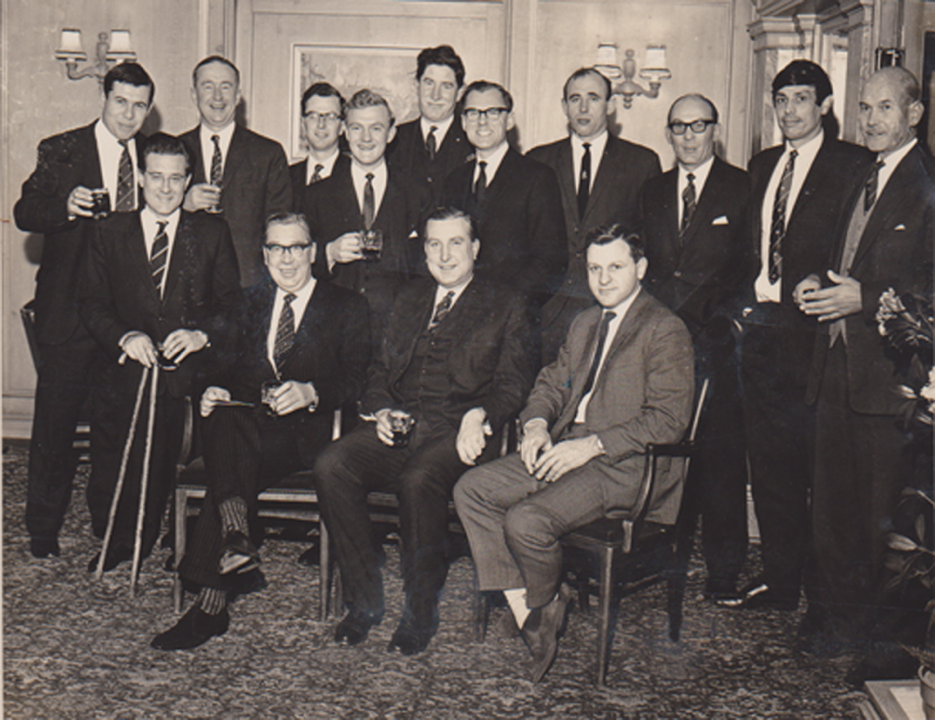
Sutton Coldfield Hockey Club celebrated its 75th anniversary with an enjoyable dinner, at Penns Hall Hotel, last Friday, when various speakers recalled past glories, congratulated the club on its steady growth and praised present players for their fine qualities, which have assured a happy future.
Club captain Maurice Wade reminded members that Sutton was one of only four clubs in the Midlands, in 1891, but today they have a respected place in hockey circles throughout the country and field five teams each Saturday.
Maurice spoke of the great players of the past, including E. B. (Torn) Crockford, who played for Great Britain and represented England 14 times. between 1911 and 1920; John Bell in the Great Britain team for the 1960 Olympics; J. Wheatcroft, who played for the county 32 times and to the present first team, with six Warwickshire players in their line-up: John Dixon, David Lumsden, Bill Boas; Neil Houghton; Chris Barber and Maurice Wade, himself.
Looking to the future, Mr. Wade said: " While the pitches in Rectory Park are at the moment far from satisfactory, the local authority have promised improvements and I am sure that if the possible merger between Sutton Coldfield Cricket Club and Sutton R.F.C. goes through, we in the hockey club will still be able to use the new facilities."
Club president Mr. John Lester introduced the speakers and among the guests were R. Williams (secretary West Midlands Standing Conference of Sports Organization: J. Brown (president. Warwickshire County Hockey Association); P. Robbins (Coventry, Warwickshire and England rugby international): J. Hadley (secretary, Birmingham Counties Hockey Umpires' Association): C. Paterson (secretary Sutton R.F.C.): C. Smith (Leamington H.C.), and R. Wilson (secretary. Sutton Coldfield Cricket Club).
The Sutton Coldfield Hockey Club was invited to play alongside Walsall, Kidderminster and the home club in a foursome tournament to celebrate the 75th Anniversary of Stourport HC on Sunday 9th April 1967. All 4 clubs will field 2 teams, an “A” and “B” side; consisting of 11 players per team and each game will be of 15 minutes duration in each half, with 2 points for a win and 1 point for a drawn game with both the “A” & “B” being aggregated to produce a total. The introduction in the program on the Sutton Coldfield HC is reproduced below.
"Rectory Park has been the headquarters of Sutton Coldfield Hockey Club since 1910. Prior to that we played at Sutton Park and Four Oaks Park. This season the club has acquired Salford Stadium for its first and second team games, which boasts facilities second to none in the Midlands.
In the early days many Sutton players gained honors for the club in Midlands and Warwickshire hockey. One player who deserves special mention is E. B. Crockford who played for England and in 1920 was a gold medalist as a member of the Great Britain Olympic Hockey Team. In 1921 the England side included two Sutton players. E. B. Crockford aid P. C. Petrie, both halfbacks.
In the seasons 1934 - 36 the club played 49 matches. won 41. drew 7 and lost 1, scoring 204 goals and conceding only 68.
Of recent years the names of John Bell (Great Britain Olympic Team 1960) and John Wheatcroft (52 caps for Warwickshire) spring to mind. Sutton players have played for the Midlands on 64 occasions and for Warwickshire on over 450 occasions.
The present playing strength of the club numbers over 70 enabling 5 regular Saturday teams to be run. Six members of the present 1st eleven have played for Warwickshire and the fact that Sutton Coldfield Hockey Club has the best playing results in the Midlands based on the results of the first four sides, indicates their playing strength in depth. The club looks forward to the future in the belief that Sutton will soon become one of the premier clubs in Midland hockey."
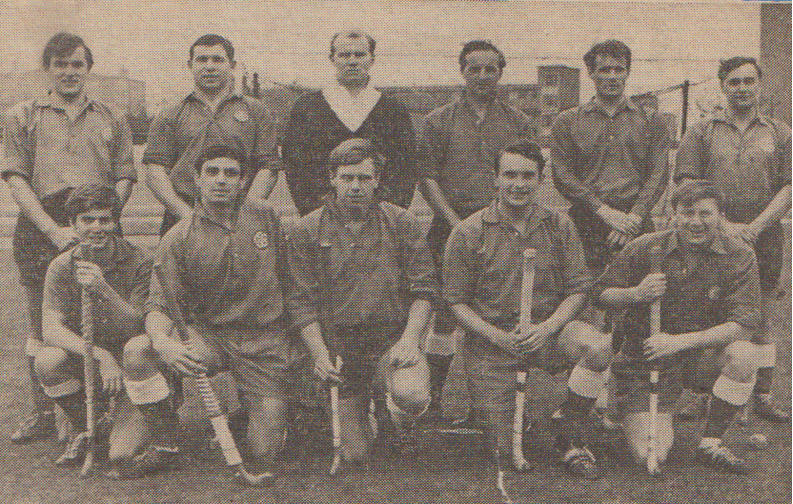
Lawton Copley family scrapbook
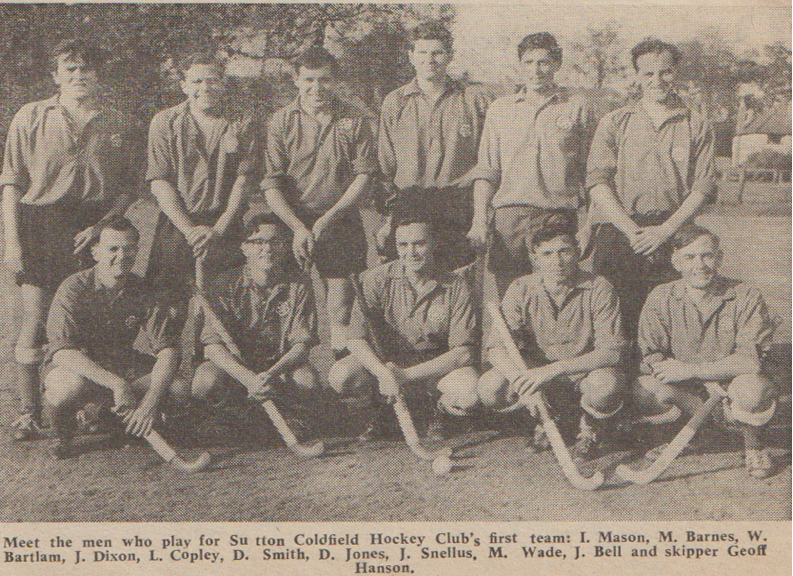
Easter Monday, in 1968 was the 21st Fort Dunlop Hockey Club’s annual festival and Sutton Club had always supported this event although most of the senior players went away for the Easter weekend to other large national festivals.
The SCHC played 7 games in a round robin of 8 clubs with 1 win, 3 draws and 3 losses, scoring 3 goals and conceding 5 in 15 minute each way games.
| 1948 | G.E.C Witton | 1955 | Cannock | 1962 | Erdington |
| 1949 | Fort Dunlop | 1956 | Cannock | 1963 | Birmingham Municipal |
| 1950 | Sutton Coldfield | 1957 | Erdington | 1964 | Sutton Coldfield |
| 1951 | Sutton Coldfield | 1958 | G.E.C Witton & Coventry | 1965 | Sutton Coldfield |
| 1952 | Birmingham Municipal | 1959 | Erdington | 1966 | Fort Dunlop |
| 1953 | G.E.C Witton & Coventry | 1960 | Erdington | 1967 | Hagley |
| 1954 | Fort Dunlop | 1961 | Fort Dunlop | 1968 | Birmingham Municipal |
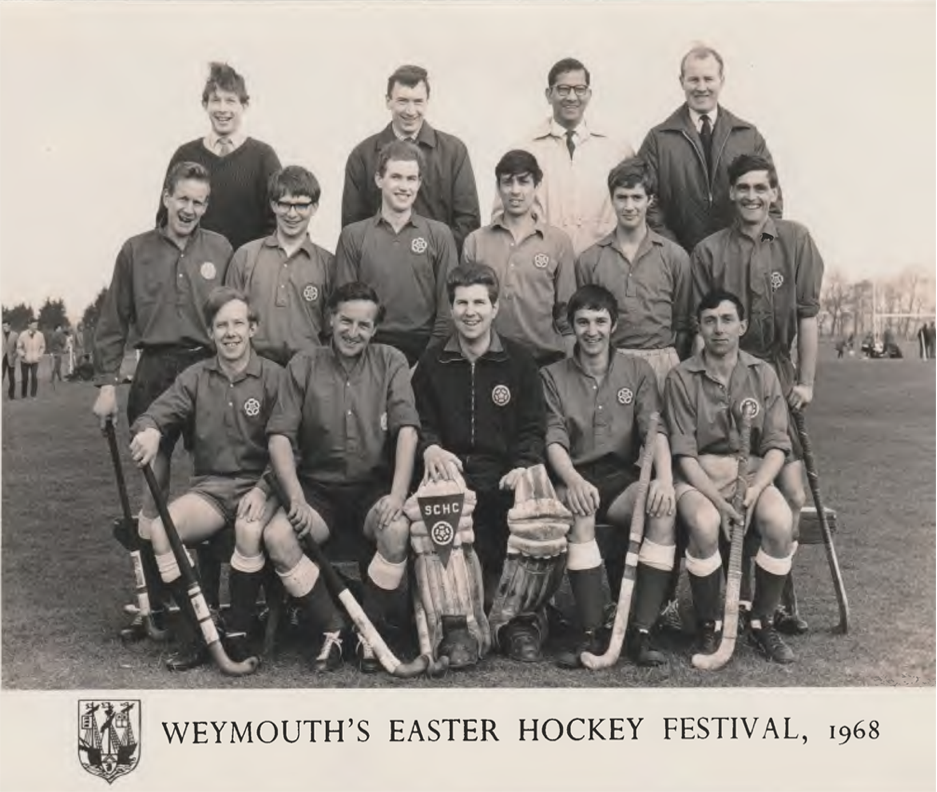
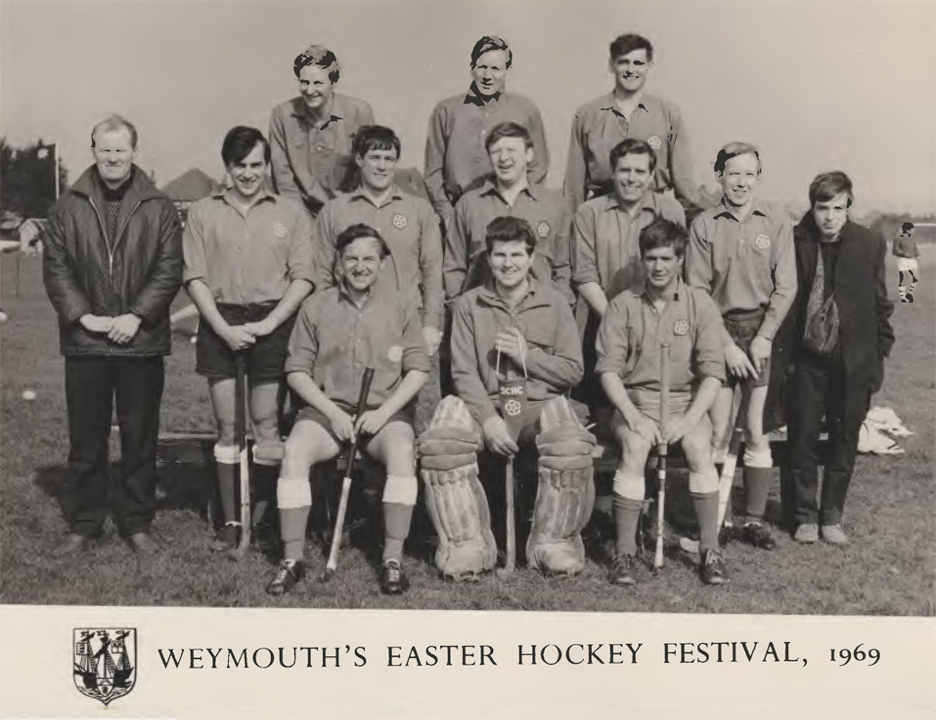
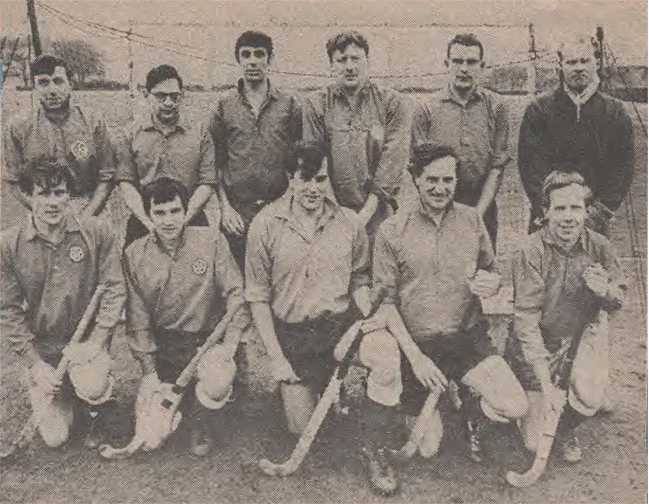
Front Row: - D. Lumsden, P. Phipps, J. Dixon (captain), L. Copley, O. Purcell.
Sutton Coldfield Men’s 2nd Team 1969
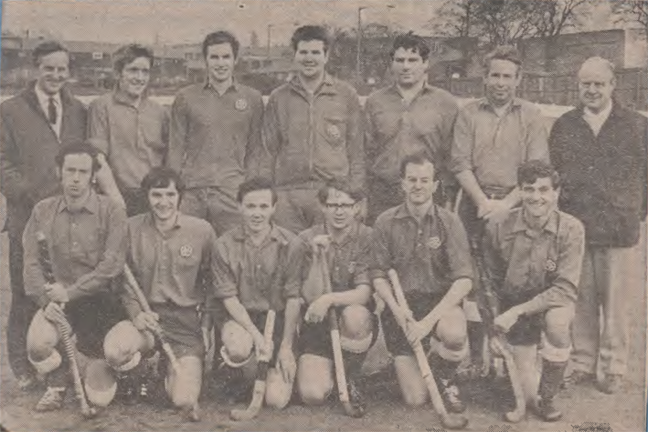
A. Spencer (President) - Front Row: - Names not known.
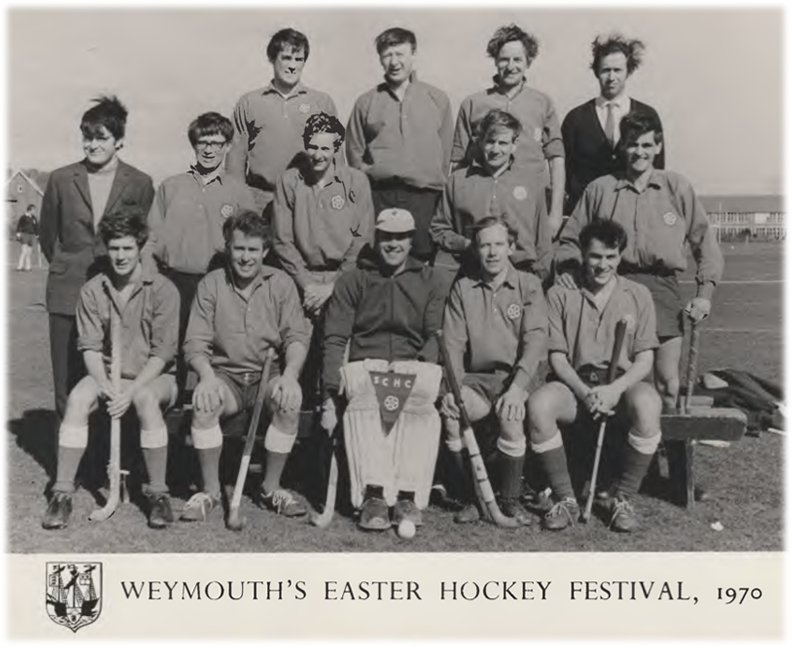
Club Records Over 9 Seasons 1962-63 to 1970-71 for the 1st, 2nd & 3rd
| Results | 1st Xl | 2nd Xl | 3rd Xl | |||||||||||||||
| P | W | L | D | F | A | P | W | L | D | F | A | P | W | L | D | F | A | |
| 1962–63 | 13 | 7 | 5 | 1 | 37 | 27 | 15 | 9 | 5 | 1 | 43 | 26 | 12 | 4 | 4 | 4 | 32 | 29 |
| 1963–64 | 21 | 7 | 6 | 8 | 50 | 46 | 20 | 16 | 1 | 3 | 56 | 17 | 19 | 9 | 8 | 1 | 44 | 31 |
| 1964–65 | 23 | 7 | 13 | 3 | 31 | 37 | 21 | 19 | 0 | 2 | 88 | 7 | 22 | 8 | 12 | 2 | 48 | 48 |
| 1965–66 | 19 | 5 | 11 | 3 | 28 | 48 | 18 | 9 | 3 | 6 | 52 | 24 | 18 | 9 | 5 | 4 | 28 | 23 |
| 1966-67 | 24 | 15 | 4 | 5 | 45 | 18 | 23 | 18 | 1 | 4 | 65 | 14 | 18 | 13 | 3 | 2 | 57 | 13 |
| 1967-68 | 23 | 9 | 7 | 7 | 27 | 25 | 25 | 11 | 6 | 8 | 47 | 28 | 20 | 11 | 5 | 4 | 47 | 20 |
| 1968-69 | 20 | 10 | 5 | 5 | 38 | 27 | 20 | 10 | 6 | 4 | 34 | 21 | 18 | 12 | 4 | 2 | 40 | 23 |
| 1969-70 | 21 | 3 | 10 | 8 | 18 | 31 | 20 | 8 | 6 | 6 | 19 | 25 | 20 | 5 | 6 | 9 | 26 | 23 |
| 1970-71 | 22 | 5 | 11 | 6 | 14 | 34 | 23 | 10 | 8 | 5 | 29 | 21 | 21 | 9 | 7 | 5 | 20 | 23 |
| Results | 4th Xl | Sunday Xl | ||||||||||
| P | W | L | D | F | A | P | W | L | D | F | A | |
| 1958-59 | 14 | 0 | 12 | 2 | 15 | 72 | ||||||
| 1959-60 | 20 | 4 | 12 | 4 | 49 | 72 | ||||||
| 1960-61 | 16 | 5 | 10 | 1 | 46 | 59 | ||||||
| 1961-62 | 25 | 12 | 12 | 1 | 49 | 60 | 13 | 5 | 5 | 3 | 34 | 29 |
| 1962–63 | 13 | 6 | 6 | 1 | 43 | 29 | 8 | 1 | 7 | 0 | 12 | 22 |
| 1963–64 | 19 | 7 | 11 | 1 | 33 | 65 | 13 | 7 | 3 | 3 | 30 | 27 |
| 1964–65 | 18 | 3 | 12 | 3 | 26 | 56 | 15 | 4 | 4 | 7 | 26 | 21 |
| 1965–66 | 14 | 3 | 10 | 1 | 19 | 51 | 10 | 4 | 2 | 4 | 20 | 9 |
| 1966-67 | 15 | 9 | 2 | 4 | 30 | 17 | 13 | 6 | 5 | 2 | 16 | 13 |
| 1967-68 | 18 | 6 | 11 | 1 | 28 | 37 | 18 | 6 | 7 | 5 | 21 | 34 |
| 1968-69 | 18 | 4 | 12 | 2 | 37 | 45 | 10 | 2 | 7 | 1 | 8 | 18 |
| 1969-70 | 16 | 2 | 13 | 1 | 13 | 51 | 11 | 3 | 5 | 3 | 11 | 20 |
| 1970-71 | 20 | 7 | 10 | 3 | 23 | 67 | 10 | 3 | 5 | 2 | 14 | 10 |
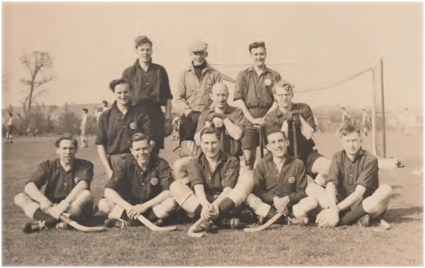
The year, team and names of the players are unknown.
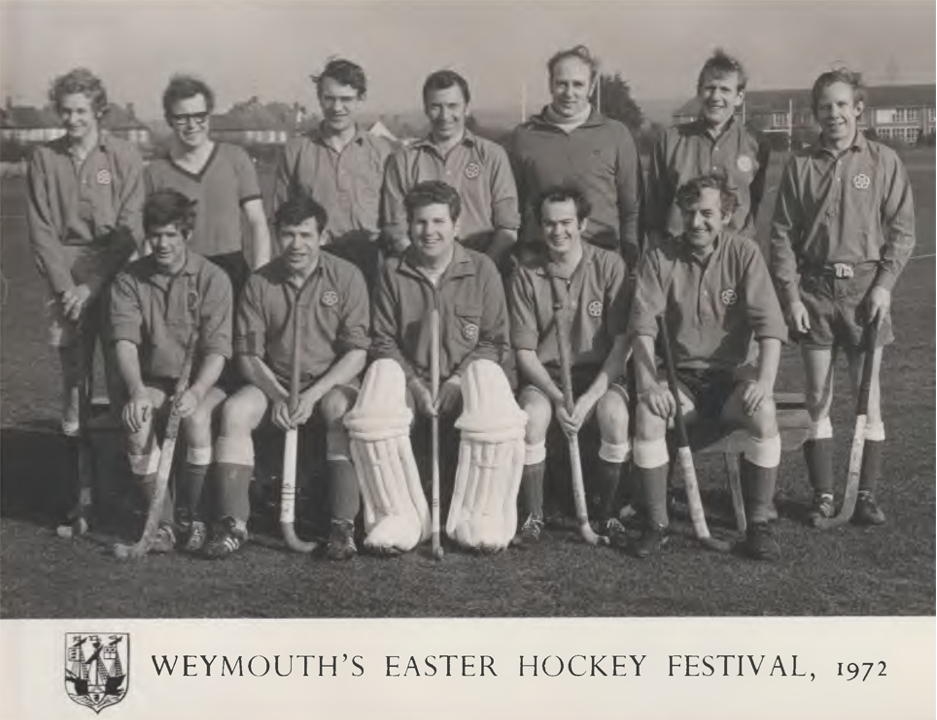
New Pavilion.
As previously mentioned, work had commenced the previous autumn and had continued throughout, the winter months, but through inevitable delays, weather, surface drainage and other problems, the building was not complete for the opening of the cricket season. The Pavilion was usable but in a somewhat chaotic state, but the Club muddled through to the end of May by which time it was seasonably presentable, though a lot of finishing touches were still necessary.
Members of both the cricket and hockey clubs made a big effort to complete in time for the opening ceremony.
The Official Ceremony took place on the evening of Friday July 25th 1970. Edmund H. King, Chairman of Warwickshire C.C.C, and a man who had distinguished himself in earlier times by playing both cricket and hockey for the County, was invited to perform the ceremony.
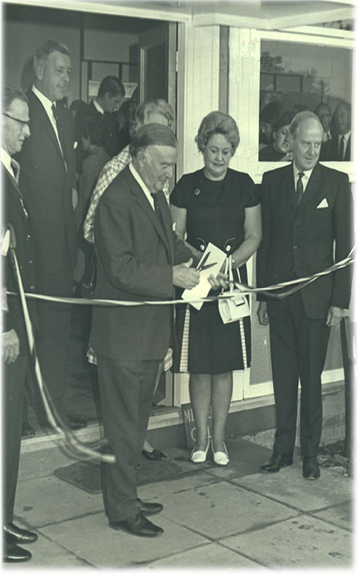
Amongst the invited guests were the Mayor and Mayoress, Alderman and Mrs. H.J.C. Musgrave, a number of notabilities in the Town. officials of Warwickshire C.C.C, Warwickshire Hockey Association, Midlands Club Cricket Conference, Members of the Press, and members and friends of many clubs.
The evening concluded with the presentation of a tankard to Charles Grove, Hon secretary of the Association, in recognition of his work and invaluable services towards the huge undertaking.
(A tape recording of the speeches was made and is in the possessions of the, Hon Secretary).
There still remained much to be done in the enclosure and surrounding areas, and these were tackled in due course. Paving slabs were laid and most of the area was turfed in the Autumn – the cost of which was kindly borne by Joe Holman, a cricket playing member and Bob Wilkinson took on Pat Bowerbank's self-imposed task of tending the roses and flower beds.
Although the Clubs, that is both section, Hockey and Cricket had raised monies for the new pavilion, funds had to be raised to cover loans made to the both Clubs. The 1969-70 season fixture card highlighted Social Fixtures, with the annual dance at the Town Hall became a joint event between the two Clubs now within the limited company. Two other events were organised a “Stag Supper at Highwayman Hotel” and a “Ladies’ Night at the Park House” and were a great success. The three events were repeated in the 1970-71 and 1971-72 seasons.
However, there was a great need to increase the revenue raise so in the 1971-72 season, 9 events were organized, all with their own organizing guru. At one such event Brian Hackett a cartoonist who was with; I think the Sports Argus attended and produced the above for the Club Captain, Lawton Copley as well for his paper.
These events covered a “Cheese & Wine”; “Bridge Night”; “Fashion Show”; Darts Nights”; Autumn, Christmas and Spring Dances and a Spring Dinner in the pavilion; and a Dinner Dance at the Park House. After so many events in a season only the Dinner Dance at the Park House survived in the 1972-73 season and it was not until the 1978-79 season then serious social fund-raising events were highlighted in the fixture card. These included “Fashion Show; “Scottish Night”; “Black Country Night”; “Children’s Christmas Party”; held in the pavilion, A jumble Sale was held in Duke Street and the Annual Dinner Dance was held in the Park House Hotel. Because of their success the “Scottish Night”; “Black Country Night”; “Children’s Christmas Party”; and the annual Dinner Dance were repeated in the 1979-89 season.
Fund raising via social events became a major Club’s activity off the pitch with ever new evening events being organized by the Club’s Social Committee in an attempt to keep members and their social friends interested in an evening in the pavilion. The pavilion, in those days, when empty, resembled a big hall stretching with very little furnishings. However, it did allow for very well attended “Film Nights”; Festival Frolic”; Beer & Skittles; “Treasure Hunt”; Mad Jocks & Englishmen”; “Horse Racing”; “Fireworks Night”; “Barbecues” and “Quiz Night”; plus the highly successful “Scottish Nights”; “Black Country Nights”; “Fashion Shows”; and “Children’s Christmas Parties”, which were all well attended and greatly entertaining, although there were many surprises, such as John Dixon’s rendering of the Australian classic” Tie me kangaroo down sport” and in the Black Country evening we were entertained by Tommy Mundon, Dolly Allen and Harry Harrison with their Black Country humor. There were also an annual Dinner Dances sometimes held in the pavilion or at the Moore Hall Hotel as well as club dinners and change of seasons parties, held both at the start and end of the season.
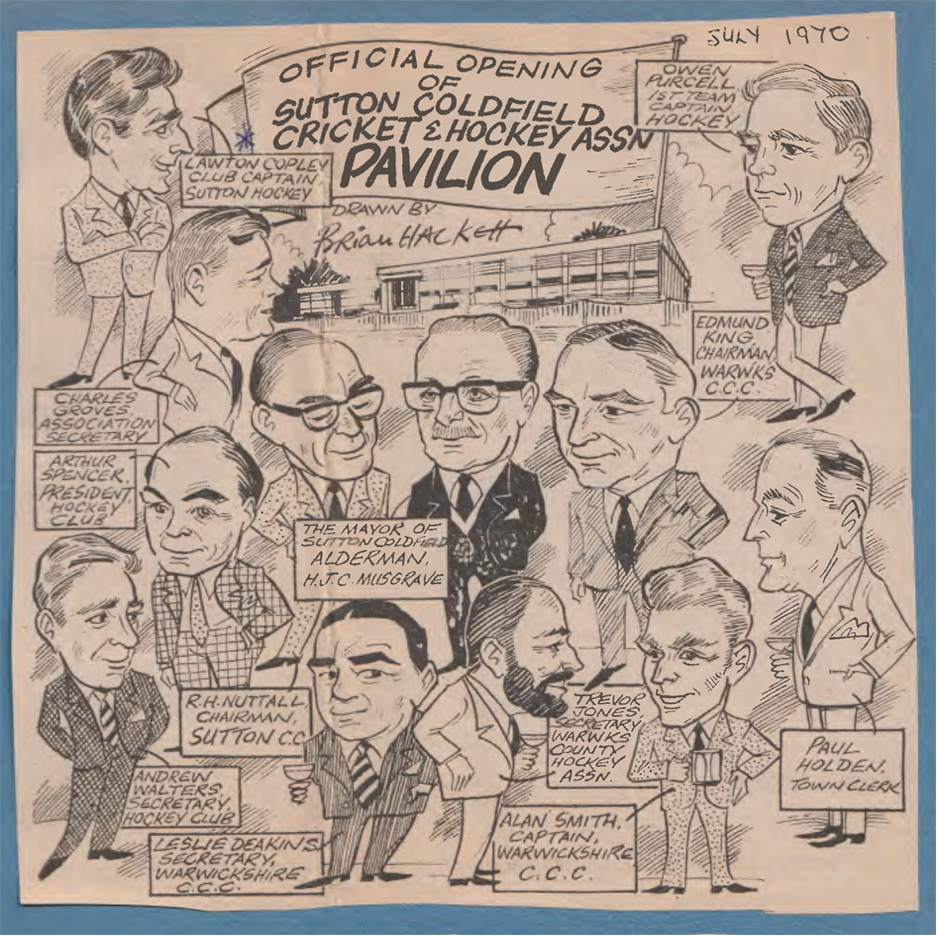
Fund raising via social events became a major Club’s activity off the pitch with ever new evening events being organised by the Club’s Social Committee in an attempt to keep members and their social friends interested in an evening in the pavilion. The pavilion, in those days, when empty, resembled a big hall stretching with very little furnishings. However, it did allow for very well attended “Film Nights”; Festival Frolic”; Beer & Skittles; “Treasure Hunt”; Mad Jocks & Englishmen”; “Horse Racing”; “Fireworks Night”; “Barbecues” and “Quiz Night”; plus the highly successful “Scottish Nights”; “Black Country Nights”; “Fashion Shows”; and “Children’s Christmas Parties”, which were all well attended and greatly entertaining, although there were many surprises, such as John Dixon’s rendering of the Australian classic” Tie me kangaroo down sport” and in the Black Country evening we were entertained by Tommy Mundon, Dolly Allen and Harry Harrison with their Black Country humor. There were also an annual Dinner Dances sometimes held in the pavilion or at the Moore Hall Hotel as well as club dinners and change of seasons parties, held both at the start and end of the season.
There were also dinner boxing evenings that took place at the Grand Hotel in Birmingham which the joint Clubs attended and with some loosely sponsoring of the ABA Birmingham branch in their evening elimination amateur boxing competition. In fact, many members of both the SCCC and SCC attended on two of the three occasions that had been promoted in the fixture card for the period 1985-86 to 1987-88 seasons. The highlight of this in the last season of such an evening was not the boxing but a false fire alarm, which we had not heard which resulted in a fireman, fully clothed, helmet and side axe, climbing into the ring while a fight was in progress, with the referee and the two boxers continuing the event. This resulted in the members in evening jackets being ushered outside the hotel while the hotel was searched, but it was a “Bomb Scare”, nevertheless the members with drinks in hand and the boxers in shorts, still wearing boxing gloves standing on the pavement for 20 minutes on a cold winter’s night.
With the present general use of the privately-owned motor car there are but few of the present generation who can have the knowledge of the difficulties of transport experienced by their predecessors in order to fulfill fixtures.
Prior to 1914 the motor car and motor bus were almost non-existent and journeys to opponents’ grounds were almost totally confined to the train and tramcar, and, moreover, grounds were frequently quite long walking distances from the stations.
For examples of these, the Olton ground in St Bernards Road was, until about 1930, only reached by a walk from Olton station, and, until about the same time, teams visiting Sutton had to walk from the Royal Oak Hotel changing rooms and return the same way, for bus services to Rectory Road and beyond had not by that time been developed to any degree.
However, by the 1930's public transport and privately owned cars were beginning to appear more frequently on the scene making it possible for players to obtain 'lifts ' if they did not have their own transport.
But although the arrival of the motor car proved of great benefit there were other factors which interfered with the relaxed attitudes necessary before going on the field. For one thing there was no such thing as a five-day week until after the second war. Almost everybody worked on Saturday mornings until midday or later, and for a 2.30 start in the darker days of winter, some players were involved in a rush to be there in time. This, in particular, applied to bank clerks, and Sutton usually had quite a few. As junior employees they were generally unable to leave until the books had been balanced (the computer age had not then arrived!). Consequently, those in the larger city banks were often detained until 1.30 or 2 pm, and at the December half yearly balance, were unable to play at all. On numerous occasions players had to change whilst travelling in a car to away fixtures. Fortunately, in these days, things are much more relaxed.

